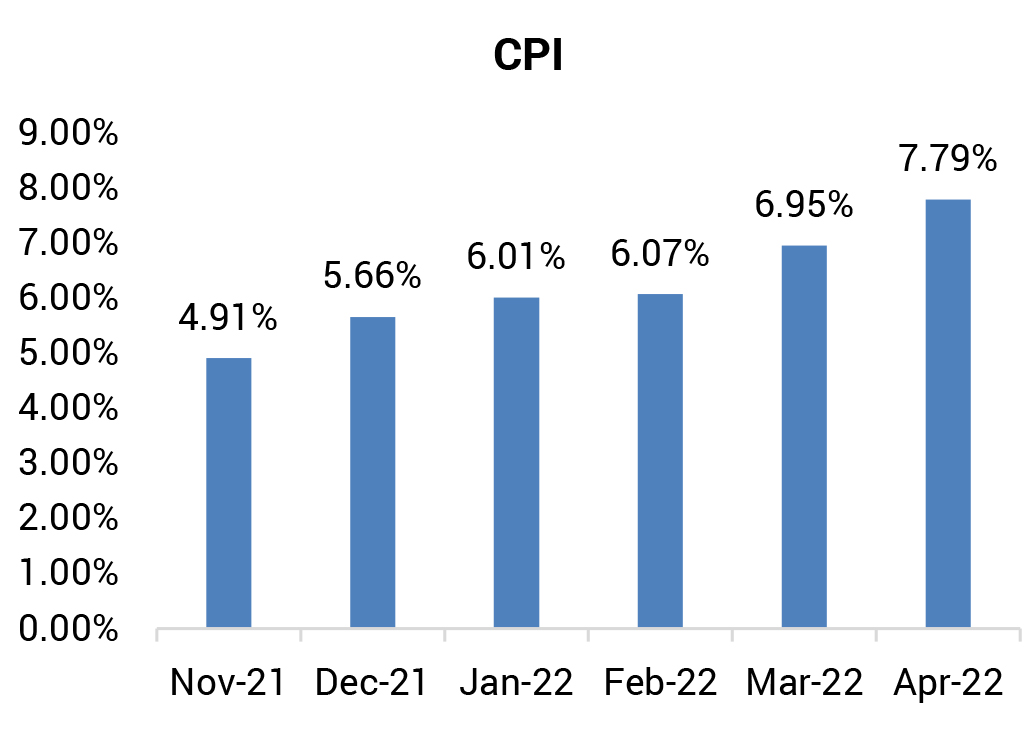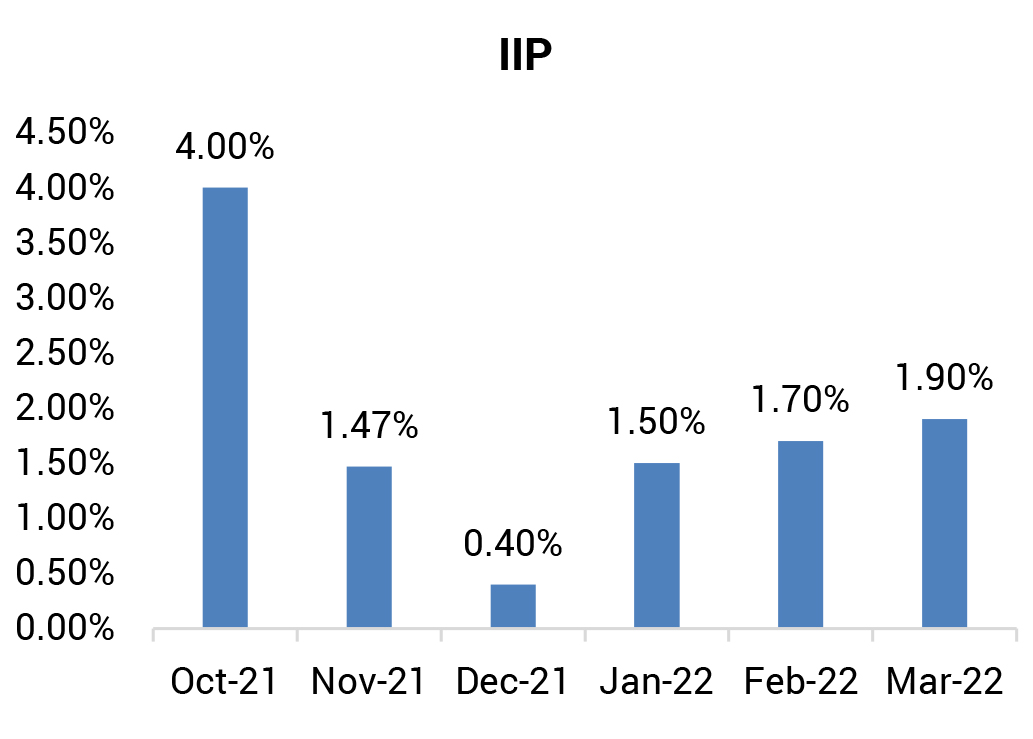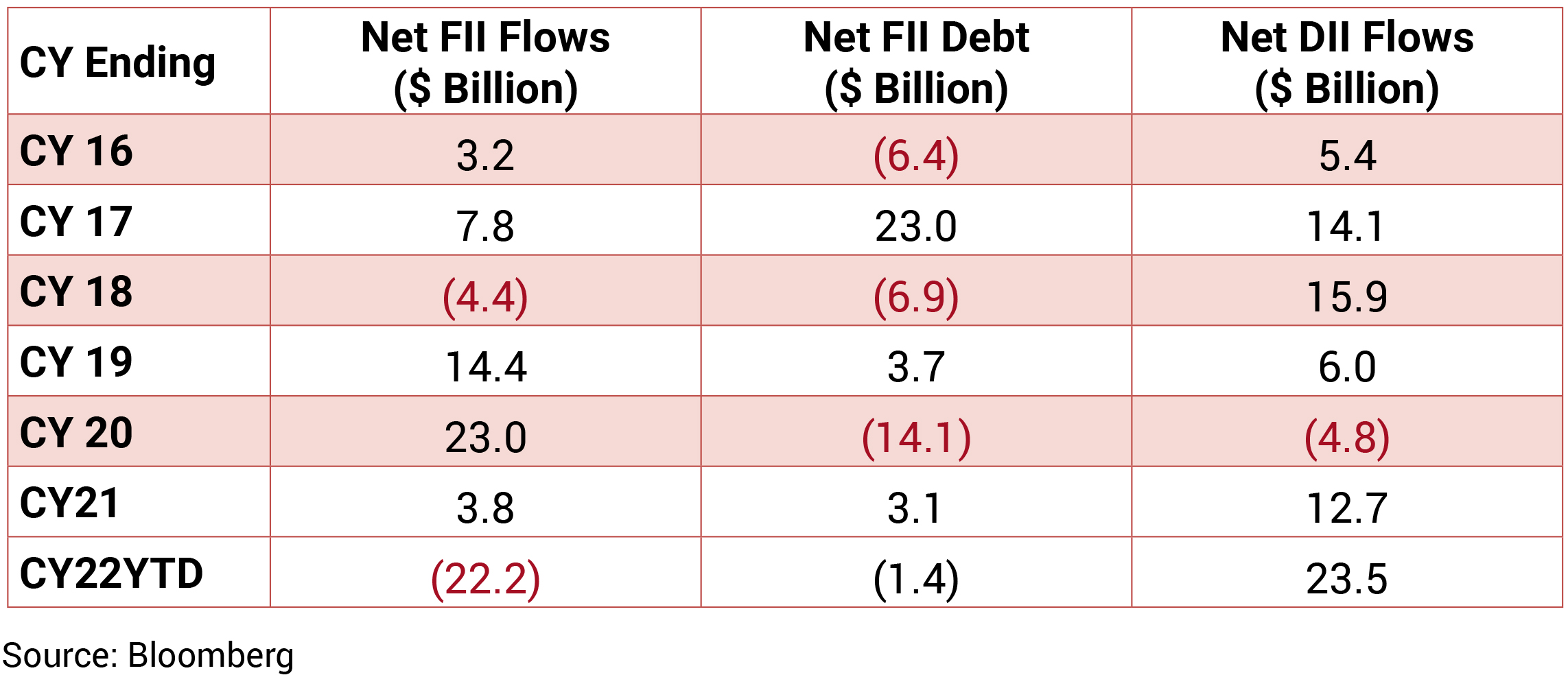Month Gone By – Markets (period ended May 31, 2022)
Markets declined 3.0% primarily dragged down by inflationary pressure, RBI rate hike and continued FIIs
selling. Consumer staples and Consumer Discretionary sector have been the frontrunner sectors while
Metals and Materials have been the laggards. The INR depreciated against USD for the fifth straight
month due to volatile crude prices and expectation of aggressive rate hike. INR averaged around 77.30
with a monthly best and worst of 76.26 and 77.73 respectively. Yields continued to ascend with the 10y
benchmark trading in a range of 7.12%-7.47% and eventually ending the month 28bps higher m-o-m at
7.42%. The 10y benchmark averaged 7.34% in May.
Inflation in US and UK remained elevated at 8.3% and 9.0% respectively in April while EU registered 8.1% inflation in May. With sustenance of inflation pressures, FOMC raised the federal funds rate further by 50bps in the last meeting in May post the 25bps increase in March. The meeting of the minutes released thereafter indicated that taming inflation is the utmost priority and signaled a similar 50bps hike in the next couple of meetings. FOMC members also supported the plan for reducing balance sheet from 1st June with a monthly cap of $47.5bn in the first three months and thereafter to be increased to $95bn. Bank of England raised their interest rates further by 25bps to attain 1%. ECB monetary policy with revised growth and inflation estimates is awaited in June to understand how the Euro area is going to respond.
On the domestic front, FY22 GDP/GVA registered 8.7%/8.1% growth slightly lower than the earlier advanced estimates. However, Q4FY22 GDP was better than market expectation. Positively, Indian fiscal deficit for FY22 was tamed at 6.7% of GDP vs. 6.9% expected according to the revised estimates supported to healthy tax collections. To tackle the inflationary concerns, RBI opted for an intermittent meeting in the first week of May and raised policy repo rate by 40bps and CRR by 50bps. Minutes of the meeting and statements to media by RBI governor indicated a further raise in repo rate in the June meeting. Government also stepped in to curb inflation with excise duty cut on petrol and diesel which immediately brought down in the retail fuel prices. These steps are expected to cool down inflation in the coming months. Government’s fiscal account for FY23 is currently under pressure due to excise duty cut and additional food & fuel subsidy. Most of the high frequency data including GST collections for May indicate robustness in economic activity.
Brent crude remains volatile and elevated averaging USD 112/bbl in May compared to USD 106/bbl in April. EU’s partial ban on Russian oil, seemingly inadequate increase in output by OPEC, and geo-political issues will keep the pressure on crude prices. Gold prices ended lower at USD 1,837/oz in May from USD 1,897/oz in April.

Inflation in US and UK remained elevated at 8.3% and 9.0% respectively in April while EU registered 8.1% inflation in May. With sustenance of inflation pressures, FOMC raised the federal funds rate further by 50bps in the last meeting in May post the 25bps increase in March. The meeting of the minutes released thereafter indicated that taming inflation is the utmost priority and signaled a similar 50bps hike in the next couple of meetings. FOMC members also supported the plan for reducing balance sheet from 1st June with a monthly cap of $47.5bn in the first three months and thereafter to be increased to $95bn. Bank of England raised their interest rates further by 25bps to attain 1%. ECB monetary policy with revised growth and inflation estimates is awaited in June to understand how the Euro area is going to respond.
On the domestic front, FY22 GDP/GVA registered 8.7%/8.1% growth slightly lower than the earlier advanced estimates. However, Q4FY22 GDP was better than market expectation. Positively, Indian fiscal deficit for FY22 was tamed at 6.7% of GDP vs. 6.9% expected according to the revised estimates supported to healthy tax collections. To tackle the inflationary concerns, RBI opted for an intermittent meeting in the first week of May and raised policy repo rate by 40bps and CRR by 50bps. Minutes of the meeting and statements to media by RBI governor indicated a further raise in repo rate in the June meeting. Government also stepped in to curb inflation with excise duty cut on petrol and diesel which immediately brought down in the retail fuel prices. These steps are expected to cool down inflation in the coming months. Government’s fiscal account for FY23 is currently under pressure due to excise duty cut and additional food & fuel subsidy. Most of the high frequency data including GST collections for May indicate robustness in economic activity.
Brent crude remains volatile and elevated averaging USD 112/bbl in May compared to USD 106/bbl in April. EU’s partial ban on Russian oil, seemingly inadequate increase in output by OPEC, and geo-political issues will keep the pressure on crude prices. Gold prices ended lower at USD 1,837/oz in May from USD 1,897/oz in April.


 Source: Bloomberg
Source: Bloomberg
IIP: March IIP growth remained lackluster at 1.9% (February: 1.5%), and increased 12.5% mom (year-end
effect). On sectoral basis, electricity production grew by 6.1% (February: 4.5%), mining by 4% (4.5%), and
manufacturing by 0.9% (0.5%). As per the use-based classification, infrastructure/construction goods
grew 7.3% and primary goods grew 5.7% while consumer durable goods and non-durable goods production
contracted by 3.2% and 5%, reflecting continued consumer demand stress.
CPI: CPI inflation in April surged to 7.79% (March: 6.95%) and increased by 1.4% mom. Food inflation rose to 8.4% (March: 7.7%) and again contributed to the bulk of inflation increase led by sequential surge in fruits (9.5%), oils and fats (2.5%), spices (2.1%), and cereals (1.1%). Core inflation (CPI excluding food, fuel, pan and tobacco) in April rose sharply to 7.3% (March: 6.6%) while increasing 1.3% mom. Rural and urban core inflation increased to 8.4% and 6.5% (March: 7.7% and 5.7%) Rural core inflation increased by 1.1% mom (March: 0.7%) led by transport and communication growing by 2.6% (0.5%), clothing and footwear by 1.1% (0.8%), and personal care 1% (1.8%). Urban core inflation increased by 1.4% mom (March: 0.47%) led by transport and communication increasing by 3.3% (0.7%), footwear by 1.2% (1.5%), housing by 1% ((-)0.1%), and personal care by 1% (1.6%).
Trade Deficit: India’s merchandise exports at USD 40.2bn in April 2022 continued to register robust growth of 30.7%. Export growth was broad-based, as 8 out of 10 major commodity groups accounting for around 70% of exports grew on a yoy basis. The improvement in export performance stemmed from the higher value of shipments of petroleum products, engineering goods and electronic goods. On a sequential basis, however, merchandise exports witnessed contraction across all major exporting segments. Merchandise imports at USD 60.3bn remained above USD 50bn for the 8th consecutive month in April 2022. Import growth was broad-based, as 9 out of 10 major commodity groups accounting for more than 75% of imports recorded an expansion on a y-o-y basis. India’s merchandise trade deficit at USD 20.1bn in April 2022 widened on a yoy basis (USD 15.3bn) as well as on a sequential basis (USD 18.5bn).
Off-cycle Monetary Policy Meeting: The RBI MPC, in an off-cycle meeting, hiked the repo rate by 40 bps to 4.4% along with CRR hike of 50 bps to 4.5%. The stance remained focused on withdrawal of accommodation. The MPC was of the view that the inflation trajectory was heavily contingent on the evolving geopolitical situation. The committee highlighted that the domestic food inflation was being pushed up by global commodity prices with high and volatile crude oil prices also posing upside risks to inflation. Core inflation is also likely to remain elevated in the near term on the back of fuel prices and essential medicines. On the growth front, the MPC drew strength from forecast of a normal monsoon and its positive impact on kharif production along with sustained recovery in contact-intensive services. Investment activity is also expected to increase through government capex. The MPC, however, noted downside risks to growth stemming from (1) rising external sector risks, (2) elevated commodity prices, (3) persistent supply bottlenecks, and (4) volatility spillovers from monetary policy normalization in advanced economies.
GDP: The Q4FY22 real GDP growth slowed to 4.1% (3QFY22: 5.4%), with private consumption being the laggard at 1.8% (Q3FY22: 7.4%). Investment growth improved to 5.1% (Q3FY22: 2.1%) and government consumption growth at 4.8% (3.0%). On the production side, Q4FY22 real GVA growth came in at 3.9% (Q3FY22: 4.7%). The growth was led by services at 5.5% and agriculture at 4.1%. Industrial sector grew by 1.3%, higher than Q3FY22 at 0.3%. FY2022 real GDP growth at 8.7% was largely supported by a significant pickup in investments by 15.8% (FY2021: (-)10.4%) and private consumption by 7.9% (FY2021: (-)6%). Government consumption registered a relatively muted increase at 2.6% (FY2021: 3.6%). Compared to FY2020 (pre-pandemic), real GDP grew by 1.5% with government consumption increasing by 6.3%, investments increasing by 3.8%, and private consumption increasing 1.4%.
CPI: CPI inflation in April surged to 7.79% (March: 6.95%) and increased by 1.4% mom. Food inflation rose to 8.4% (March: 7.7%) and again contributed to the bulk of inflation increase led by sequential surge in fruits (9.5%), oils and fats (2.5%), spices (2.1%), and cereals (1.1%). Core inflation (CPI excluding food, fuel, pan and tobacco) in April rose sharply to 7.3% (March: 6.6%) while increasing 1.3% mom. Rural and urban core inflation increased to 8.4% and 6.5% (March: 7.7% and 5.7%) Rural core inflation increased by 1.1% mom (March: 0.7%) led by transport and communication growing by 2.6% (0.5%), clothing and footwear by 1.1% (0.8%), and personal care 1% (1.8%). Urban core inflation increased by 1.4% mom (March: 0.47%) led by transport and communication increasing by 3.3% (0.7%), footwear by 1.2% (1.5%), housing by 1% ((-)0.1%), and personal care by 1% (1.6%).
Trade Deficit: India’s merchandise exports at USD 40.2bn in April 2022 continued to register robust growth of 30.7%. Export growth was broad-based, as 8 out of 10 major commodity groups accounting for around 70% of exports grew on a yoy basis. The improvement in export performance stemmed from the higher value of shipments of petroleum products, engineering goods and electronic goods. On a sequential basis, however, merchandise exports witnessed contraction across all major exporting segments. Merchandise imports at USD 60.3bn remained above USD 50bn for the 8th consecutive month in April 2022. Import growth was broad-based, as 9 out of 10 major commodity groups accounting for more than 75% of imports recorded an expansion on a y-o-y basis. India’s merchandise trade deficit at USD 20.1bn in April 2022 widened on a yoy basis (USD 15.3bn) as well as on a sequential basis (USD 18.5bn).
Off-cycle Monetary Policy Meeting: The RBI MPC, in an off-cycle meeting, hiked the repo rate by 40 bps to 4.4% along with CRR hike of 50 bps to 4.5%. The stance remained focused on withdrawal of accommodation. The MPC was of the view that the inflation trajectory was heavily contingent on the evolving geopolitical situation. The committee highlighted that the domestic food inflation was being pushed up by global commodity prices with high and volatile crude oil prices also posing upside risks to inflation. Core inflation is also likely to remain elevated in the near term on the back of fuel prices and essential medicines. On the growth front, the MPC drew strength from forecast of a normal monsoon and its positive impact on kharif production along with sustained recovery in contact-intensive services. Investment activity is also expected to increase through government capex. The MPC, however, noted downside risks to growth stemming from (1) rising external sector risks, (2) elevated commodity prices, (3) persistent supply bottlenecks, and (4) volatility spillovers from monetary policy normalization in advanced economies.
GDP: The Q4FY22 real GDP growth slowed to 4.1% (3QFY22: 5.4%), with private consumption being the laggard at 1.8% (Q3FY22: 7.4%). Investment growth improved to 5.1% (Q3FY22: 2.1%) and government consumption growth at 4.8% (3.0%). On the production side, Q4FY22 real GVA growth came in at 3.9% (Q3FY22: 4.7%). The growth was led by services at 5.5% and agriculture at 4.1%. Industrial sector grew by 1.3%, higher than Q3FY22 at 0.3%. FY2022 real GDP growth at 8.7% was largely supported by a significant pickup in investments by 15.8% (FY2021: (-)10.4%) and private consumption by 7.9% (FY2021: (-)6%). Government consumption registered a relatively muted increase at 2.6% (FY2021: 3.6%). Compared to FY2020 (pre-pandemic), real GDP grew by 1.5% with government consumption increasing by 6.3%, investments increasing by 3.8%, and private consumption increasing 1.4%.

Deal flow picked up in May with 21 deals worth ~USD 4.07 billion executed. Key deals included LIC (~USD
2.66B) and Delhivery (~USD 675M).
FIIs continued being net sellers in the month of May 2022 and were net sellers to the tune of –USD 4.87bn even as DII buying continued at +USD 6.57bn. MFs had put in +3.1bn till 26th May 2022.
FIIs continued being net sellers in the month of May 2022 and were net sellers to the tune of –USD 4.87bn even as DII buying continued at +USD 6.57bn. MFs had put in +3.1bn till 26th May 2022.

